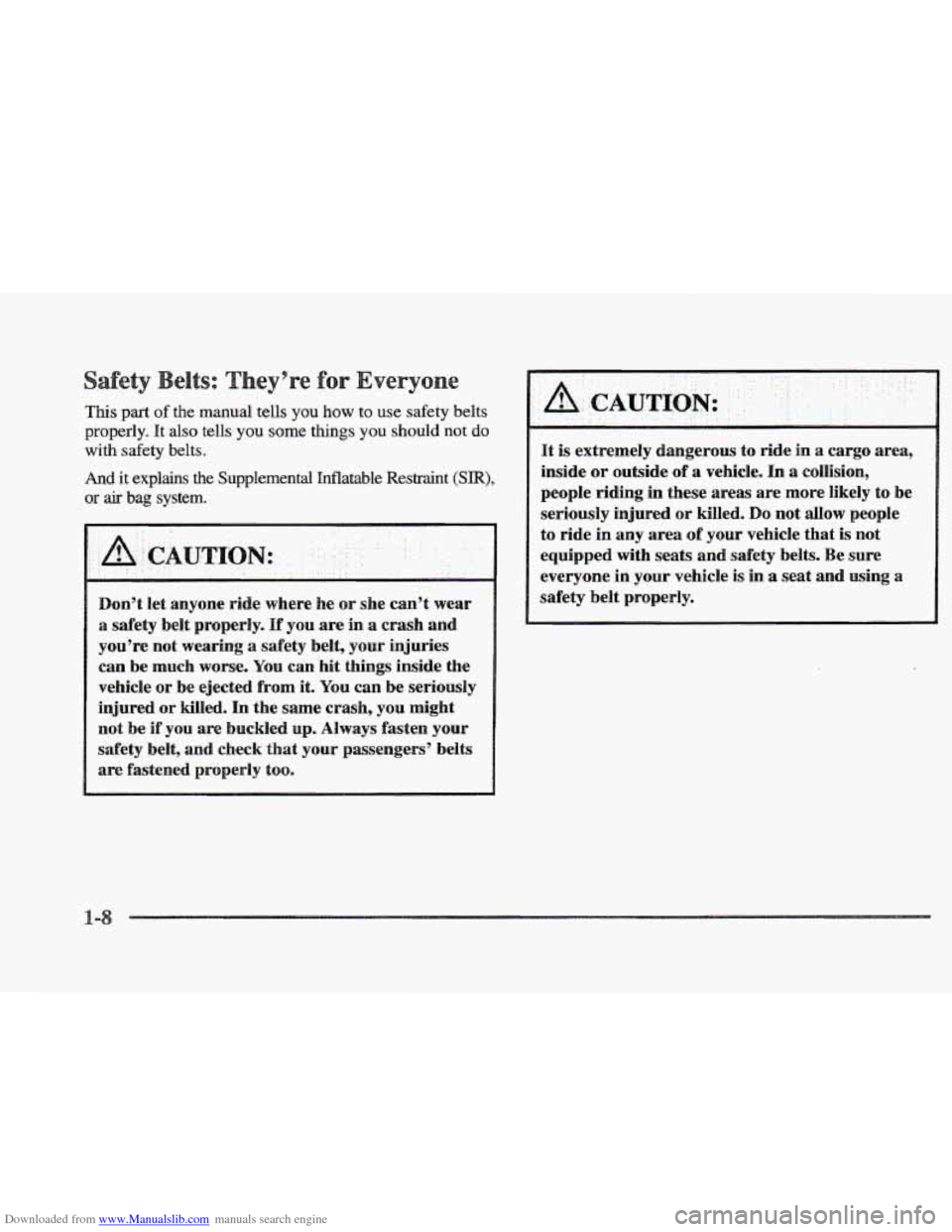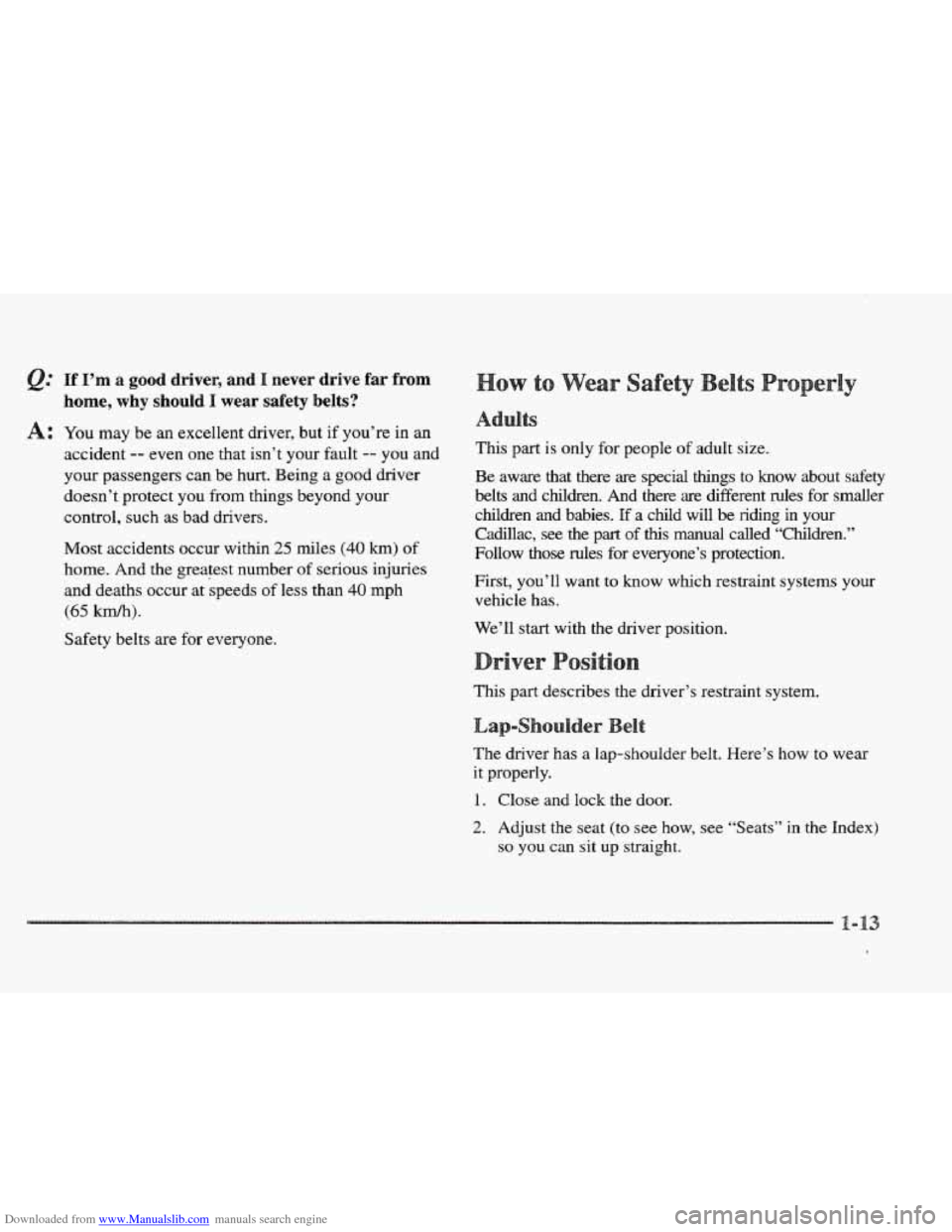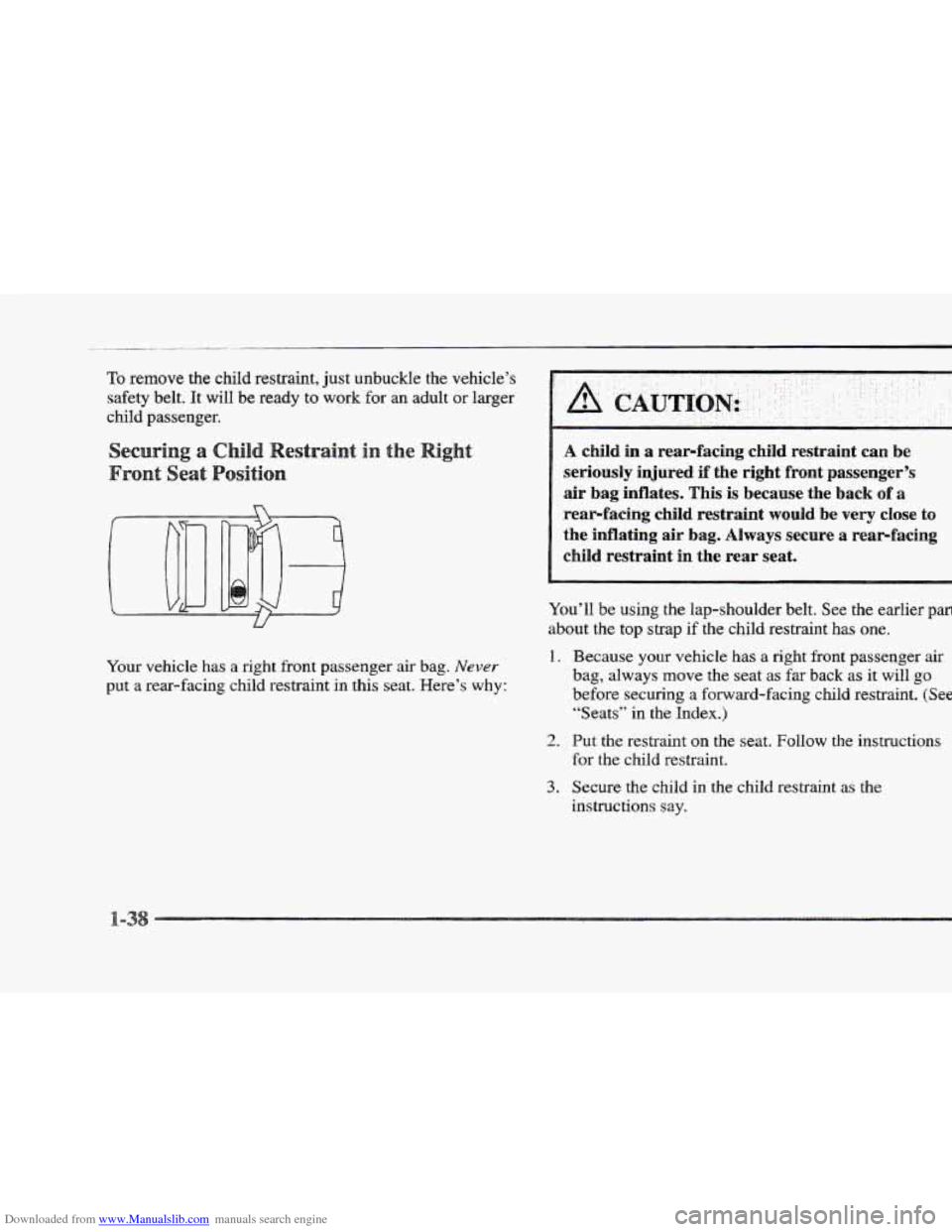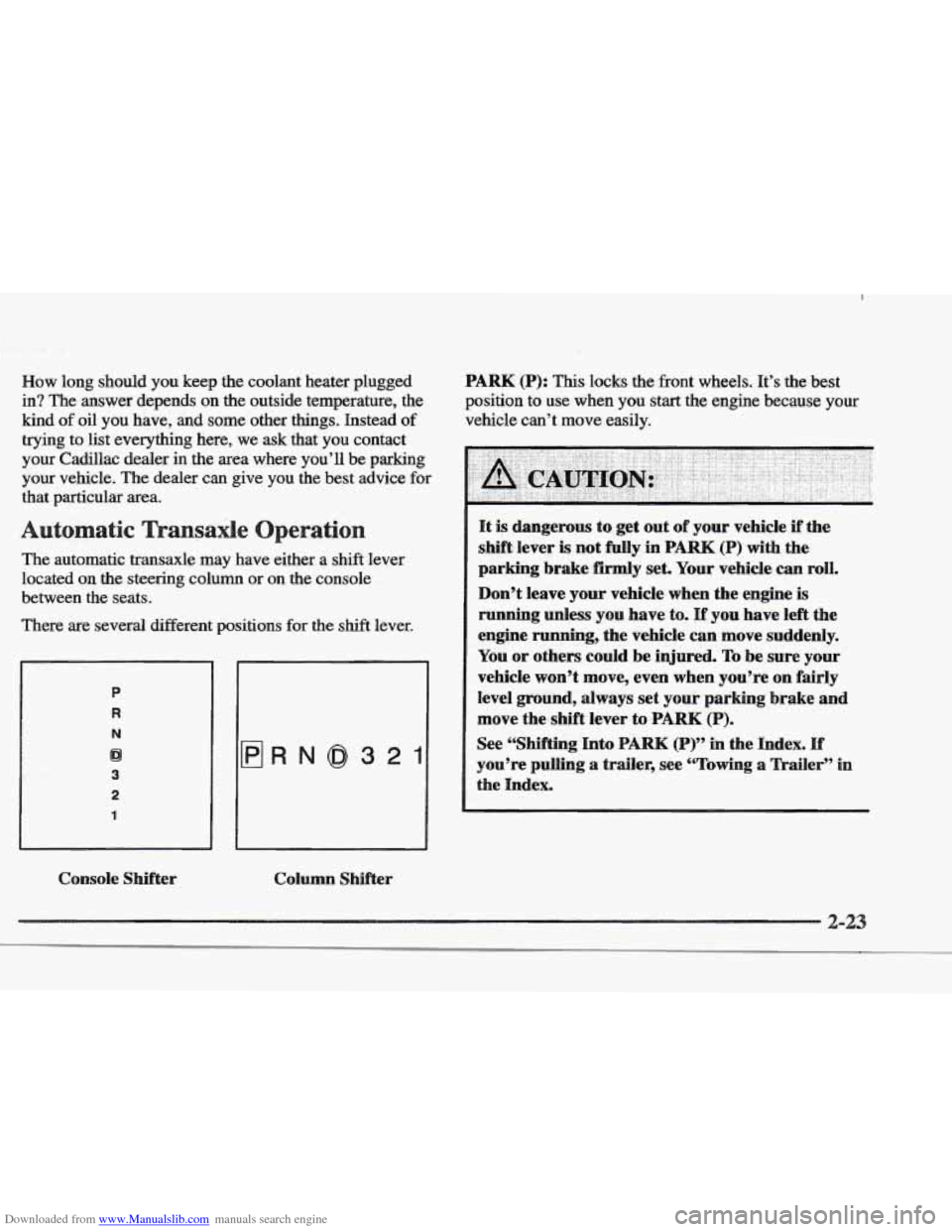Page 6 of 361

Downloaded from www.Manualslib.com manuals search engine 1-1
2-1
5-1
6-1
7-1
8-1
Seats and Restraint Systems
This section tells you how to use your seats and safety belts properly. It also explains the “SIR’ system.
Features and Controls
This section explains how to stat and operate your Cadillac.
Comfort Contrds and Audio Systems
This section tells you how to adjust the ventilation and comfort controls and how to operate your audio system.
Your Driving sand the Road
Here you’ll find helpful information and tips about the road and how to drive under different conditions.
Problems on the Woad
This section tells what to do jf you have a problem while driving, such as a flat tire or overheated engine, etc.
Service and Appearance Care
Here the manual tells you how to keep your Cadillac running properly and looking good.
Customer Assistance InfmmtiaPm
This section tells you how to contact Cadillac for assistance and how to get service and owner publications.
It
also gives you information on “Reporting Safety Defects” on page 7- 12.
Index
Here’s an alphabetical listing of almost every subject in this manual. You can use it to quickly find
something
you want to read.
i
Page 20 of 361
Downloaded from www.Manualslib.com manuals search engine Here you’ll find information about the seats in your Cadillac and how to use your safety belts properly. You can also
learn about some things you should 12ot do with air bags and safety belts.
1-2
1-8
1-12
1-13
1-13
1-20
1-21
1-21
Seats and Seat Controls
Safety Belts: They’re for Everyone
Here Are Questions
Many People Ask About
Safety Belts
-- and the Answers
HOW to Wear Safety Belts Properly
Driver Position Safety Belt
Use During Pregnancy
Right Front Passenger Position Supplemental Inflatable
Restraint
(SN) System
1-27
1 -30
1-3 1
1-33
1-40
1-43
1-43
1-43 Rear Seat Passengers
Center Passenger Position
Children
Child Restraints
Larger Children
Safety Belt Extender
Checking Your Restraint Systems
Replacing Restraint System
Parts After
a Crash
Page 21 of 361
Downloaded from www.Manualslib.com manuals search engine s s
This section tells you about the power seats -- how to
adjust them, and also about reclining front seatbacks,
lumbar adjustments, head restraints, heated seats and
seatback latches. The
power seat controls are located on the outboard side
of the front seat cushion.
Q
(B
Move the front of the control in the direction of the
arrows to adjust the front portion of the cushion up
or down.
Move the rear of the control in the direction of the
arrows to adjust the rear portion
of the cushion up
or down.
Lift
up or push down on both outer arrows at the
same time
to move the entire seat up or down.
To move the whole seat forward or backward, slide
the control in the direction of the center arrow.
Page 24 of 361
Downloaded from www.Manualslib.com manuals search engine The control is located in the
center console. Move the
switch to LO or HI to turn
the heating elements in
the seat. The
EO setting
warms the seatback and
cushion until the seat
approximates body
temperature. The
HI setting
heats the seat
to a slightly
higher temperature.
A telltale light in the control reminds you that the
heating system is
in use. The heated seats can only be
used when the ignition is turned on.
Press the control forward
or rearward to adjust
the seatback.
Page 27 of 361

Downloaded from www.Manualslib.com manuals search engine This part of the manual tells you how to use safety belts
properly. It also tells you some things you should not do
with safety belts.
And it explains the Supplemental Inflatable Restraint (SIR),
or air bag system.
Don’t let anyone ride where he or
she can’t wear
a safety belt properly.
If you are in a crash and
you’re not wearing
a safety belt, your injuries
can be much worse.
You can hit things inside the
vehicle
OF be ejected from it. You can be seriously
injured
or killed. In the same crash, you might
not be if
you are buckled UP. Always fasten your
safety
belt, and check that your passengers’ belts
are fastened
properly too.
. .. . . .. . . .. .. . . .. , ,. . .. ,
~~
It is extremely dangerous &Q ride in a cargo area,
inside or outside of
a vehicle. In a collision,
people riding in these areas are more likely to be
seriously injured
or killed. Do not allow people
to ride in any area
of your vehicle that is not
equipped with seats and safety belts. Be sure
everyone in your vehicle is in
a seat and using a
safety belt pr~pedgr.
Page 32 of 361

Downloaded from www.Manualslib.com manuals search engine : If I’m a good driver, and 1 never drive far from
home, why should I wear safety belts?
A You may be an excellent driver, but if you’re in an
accident
-- even one that isn’t your fault -- you and
your passengers can be hurt. Being
a good driver
doesn’t protect you from things beyond your
control, such as bad drivers.
Most accidents occur within 25 miles (40 km) of
home. And the greatest number of serious injuries
and deaths occur at speeds
of less than 40 mph
(65 kdh).
Safety belts are for everyone.
W Y Y
This part is only for people of adult size.
Be aware that there
are special things to know about safety
belts and children. And there
are different rules for smaller
children and babies.
If a child will be riding in your
Cadillac, see the
part of this manual called “Children.”
Follow those rules for everyone’s protection.
First, you’ll want to know which restraint systems your
vehicle has.
We’ll start with
the driver position.
This part describes the driver’s restraint system.
The driver has
a lap-shoulder belt. Here’s how to wear
it properly.
1. Close and lock the door.
2. Adjust the seat (to see how, see “Seats” in the Index)
so you can sit up straight.
Page 57 of 361

Downloaded from www.Manualslib.com manuals search engine To remove the child restraint, just unbuckle the vehicle’s
safety belt. It will be ready to work for
an adult or larger
child passenger.
Your vehicle has
a right front passenger air bag. Never
put a rear-facing child restraint in this seat. Here’s why:
A child in a rearfacing child restraint can be
seriously injured if the right front passenger’s
air bag inflates. This is because the back
of a
rear-facing child restraint would be very close to
the inflating air bag. Always secure a rearfacing
child restraint in the rear seat.
You’ll be using the lap-shoulder belt. See the earlier part
about the top strap if the child restraint has one.
1. Because your vehicle has a right front passenger air
bag, always move the seat as
far back as it will go
before securing a forward-facing chld restraint. (See
“Seats” in the Index.)
2. Put the restraint on the seat. Follow the instructions
for the child restraint.
3. Secure the child in the child restraint as the
instructions say.
Page 86 of 361

Downloaded from www.Manualslib.com manuals search engine How long should you keep the coolant heater plugged
in? The answer depends on the outside temperature, the
kind
of oil you have, and some other things. Instead of
trying to list everything here, we ask that you contact
your Cadillac dealer in the area where you’ll be parking
your vehicle. The dealer can give you the best advice for
that particular area.
The automatic transaxle may have either a shift lever
located on the steering
column or on the console
between
the seats.
There are several different positions for the
shift lever.
P
R
N
Dl
3
2
1
HRN@321
Console Shifter Collnmn Shifter PARK
(P): This locks
the.front wheels. It’s the best
position to use when you start the engine because your
vehicle can’t move easily.
It is dangerous to get out of your vehicle if the
shift lever
is not fully in PARK (P) with the
parking brake firmly set. Your vehicle
can roll.
Don’t leave your vehicle when the engine
is
running unless you have to. If you have left the
engine running, the vehicle can move suddenly.
You
or others could be injured. To be sure your
vehicle won’t move, even when you’re on fairly
leveI ground, always set your
parking brake and
move the shift lever to
PARK (P).
See “Shifting Into PARK (P)” in the Index. If
you’re pulling a trailer, see “Towing a Trailer” in
the Index.
2-23